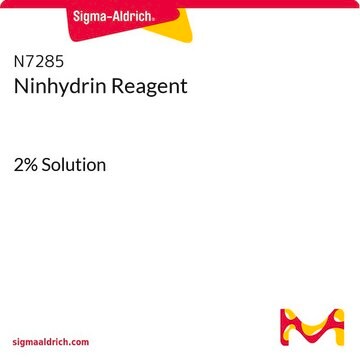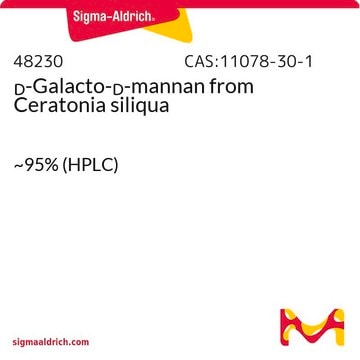Products may be shipped at a different temperature than the recommended long-term storage temperature. If the product quality is sensitive to short-term exposure to conditions other than the recommended long-term storage, it will be shipped on wet or dry-ice. If the product quality is NOT affected by short-term exposure to conditions other than the recommended long-term storage, it will be shipped at ambient temperature. As shipping routes are configured for minimum transit times, shipping at ambient temperature helps control shipping costs for our customers. For more information, please refer to the Storage and Transport Conditions document: https://www.sigmaaldrich.com/deepweb/assets/sigmaaldrich/marketing/global/documents/316/622/storage-transport-conditions-mk.pdf
P2297
Ácido picrilsulfónico solution
5 % (w/v) in H2O, BioReagent, suitable for determination of primary amines
Sinónimos:
TNBS, Ácido 2,4,6-trinitrobencenosulfónico solution
Seleccione un Tamaño
205,00 €
Seleccione un Tamaño
About This Item
205,00 €
Productos recomendados
grado
reagent
Línea del producto
BioReagent
concentración
5 % (w/v) in H2O
idoneidad
suitable for determination of primary amines
temp. de almacenamiento
2-8°C
cadena SMILES
OS(=O)(=O)c1c(cc(cc1[N+]([O-])=O)[N+]([O-])=O)[N+]([O-])=O
InChI
1S/C6H3N3O9S/c10-7(11)3-1-4(8(12)13)6(19(16,17)18)5(2-3)9(14)15/h1-2H,(H,16,17,18)
Clave InChI
NHJVRSWLHSJWIN-UHFFFAOYSA-N
¿Está buscando productos similares? Visita Guía de comparación de productos
Categorías relacionadas
Descripción general
Aplicación
- para evaluar la eficiencia de las modificaciones carboximetillisínicas (LMC) de aminas primarias expuestas
- para incubar embriones bovinos de zona intactos para la tinción diferencial de blastocistos
- para inducir el síndrome de intestino irritable (SII) en ratones y para estudiar sus efectos sobre Clostridium butyricum
Producto relacionado
Palabra de señalización
Danger
Frases de peligro
Consejos de prudencia
Clasificaciones de peligro
Eye Dam. 1 - Skin Corr. 1B - Skin Sens. 1
Código de clase de almacenamiento
8B - Non-combustible corrosive hazardous materials
Clase de riesgo para el agua (WGK)
WGK 3
Punto de inflamabilidad (°F)
Not applicable
Punto de inflamabilidad (°C)
Not applicable
Elija entre una de las versiones más recientes:
Certificados de análisis (COA)
¿No ve la versión correcta?
Si necesita una versión concreta, puede buscar un certificado específico por el número de lote.
¿Ya tiene este producto?
Encuentre la documentación para los productos que ha comprado recientemente en la Biblioteca de documentos.
Los clientes también vieron
-
How is shipping temperature determined? And how is it related to the product storage temperature?
1 respuesta-
¿Le ha resultado útil?
-
-
How can I determine the shelf life / expiration / retest date of this product?
1 respuesta-
If this product has an expiration or retest date, it will be shown on the Certificate of Analysis (COA, CofA). If there is no retest or expiration date listed on the product's COA, we do not have suitable stability data to determine a shelf life. For these products, the only date on the COA will be the release date; a retest, expiration, or use-by-date will not be displayed.
For all products, we recommend handling per defined conditions as printed in our product literature and website product descriptions. We recommend that products should be routinely inspected by customers to ensure they perform as expected.
For products without retest or expiration dates, our standard warranty of 1 year from the date of shipment is applicable.
For more information, please refer to the Product Dating Information document: https://www.sigmaaldrich.com/deepweb/assets/sigmaaldrich/marketing/global/documents/449/386/product-dating-information-mk.pdf¿Le ha resultado útil?
-
-
この製品は水とTNBS以外に何かが含まれていますか?
1 respuesta-
The exact composition of this product is proprietary. No preservatives or stabilizers have been added.
¿Le ha resultado útil?
-
-
Is this product suitable for IBD induction in mouse models?
1 respuesta-
As listed on the website, this product, picrylsulfonic acid solution, has been used in the following:
-to assess the efficiency of carboxymethyl lysine (CML) modifications of exposed primary amines
-to incubate zona intact bovine embryos for the differential staining of blastocysts
-to induce irritable bowel syndrome (IBS) in mice and to study its effects on Clostridium butyricumIt has not been validated in the use for IBD induction in mouse models.
¿Le ha resultado útil?
-
-
Is Product P2297, Picrylsulfonic acid solution, considered to be stable?
1 respuesta-
It is explosive when it is dry. The solution should be stored at 2-8°C in the dark. Under these conditions less than 5% decomposition will occur over five months. At 37°C, 50% decomposition occurred in 60 days. Picrylsulfonic acid decomposes to picric acid, crystals of which may form in the solution, but this impurity causes no interference in usage. The solution may also contain a trace amount of 2,4-dinitrophenol (typically °C may enhance shelf-life of stock solutions.
¿Le ha resultado útil?
-
-
What are the suggested storage conditions for Product P2297, Picrylsulfonic acid solution?
1 respuesta-
Store Product No. P2297 at 2-8°C in the dark.
¿Le ha resultado útil?
-
-
Is Product P2297, Picrylsulfonic acid solution, supposed to be yellow?
1 respuesta-
Yes. This product is a clear to slightly hazy yellow solution at room temperature. The solution has a concentration of 5 w/v % in H2O (5g per 100 mL).
¿Le ha resultado útil?
-
-
What is the Department of Transportation shipping information for this product?
1 respuesta-
Transportation information can be found in Section 14 of the product's (M)SDS.To access the shipping information for this material, use the link on the product detail page for the product.
¿Le ha resultado útil?
-
-
In general, what is Product P2297, Picrylsulfonic acid solution, used for?
1 respuesta-
Picrylsulfonic acid has been used 1) As a hydrophilic modifying reagent[1]; 2) To make derivatives with amino compounds, which can be regenerated with hydrazine [2].
¿Le ha resultado útil?
-
-
How is Product P2297, Picrylsulfonic acid solution, tested? Do you have any references for its use besides Sigma's method?
1 respuesta-
Sigma's suitability assay is based on a published method.1 We use a 500-fold dilution as a working solution, with glycine as a standard. Hydrochloric acid is used to stop the reaction, and to reduce yellow background due to picric acid. Sodium phosphate is used as a buffer in place of sodium bicarbonate to avoid formation of CO2 when HCl is added. Absorbance is read at 420 nm.Other procedures have been published. For example:---Twenty-five mL of 0.03 M TNBS is added to 1 mL of sample (in borate buffer), agitated to ensure complete mixing, and allowed to stand for 30 minutes at room temperature (25±1°C). No quenching step is used. In the blank, buffer replaces sample. Absorbance is read at 420 nm.2---Protocols using a more concentrated solution of picric acid (1.1 M) have been published.3Note: TNBS forms an orange complex with amines, monitored at 420 nm, but the EmM of the complexes will vary with the reacting group: for alpha-amino groups, 22.0; for epsilon-amino groups, somewhat lower; and for thiol groups, 2.25.3References:1. Satake, K. et al., J. Biochem., 47, 654 (1960).2. Snyder, S.L. and Sobocinski P.Z., Anal. Biochem., 64, 284-288 (1975).3. Fields, R., Methods in Enzymology, 25, 464-468 (1972).
¿Le ha resultado útil?
-
Filtros activos
Nuestro equipo de científicos tiene experiencia en todas las áreas de investigación: Ciencias de la vida, Ciencia de los materiales, Síntesis química, Cromatografía, Analítica y muchas otras.
Póngase en contacto con el Servicio técnico










